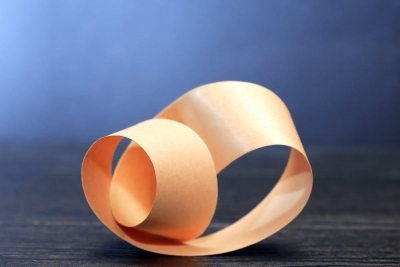
To make a Mobius strip, take a strip of paper, give it half a twist, then join the ends to form a band. Run a pencil round and you’ll find the strip has one single edge. It was named after the 19th century mathematician Augustus Mobius.
You can make a model of the Mobius strip with just a rectangular piece of paper: give it an odd number of half-twists, then tape the ends back together. But the strip was long thought never to occur in the natural world. Because it has never been observed in our organic environment, it is sometimes referred to as an “impossible shape.” Practical applications of it abound in the world of human invention, however. For instance, Mobius strips are used in continuous-loop recording tapes, typewriter ribbons and computer print cartridges. In the 1960s, Sandia Laboratories also used Mobius bands in the design of adaptable electronic resistors. Conveyor belts use Mobius strips because they allow the entire surface area of the belt to receive an equal amount of wear, which makes it last longer.
The Mobius strip has also been tailored to various artistic and cultural products. Paintings have displayed Mobius shapes, as have earrings, necklaces and other pieces of jewelry. The green, three-arrowed universal sign for recycling also composes the Mobius band. There’s a depth to the image that reminds you to reduce, reuse and recycle. It is not just a circular action; it’s dynamic. The symbol seeks to represent the three interdependent aspects of a sustainable loop: the collection of materials to be recycled, the manufacturing of recycled materials into new products, and the purchase and use of the products made from recycled materials. Each arrow pleats and pivots itself, as all three arrows pursue and power one another.
Credit : Scientific American
Picture Credit : Google




